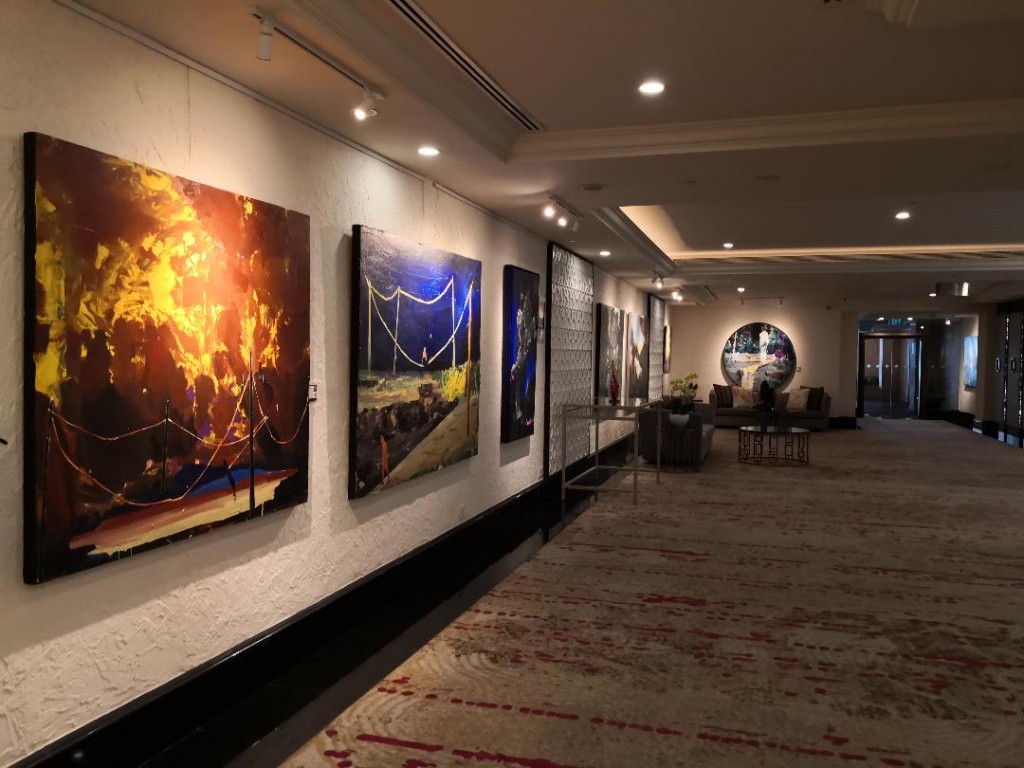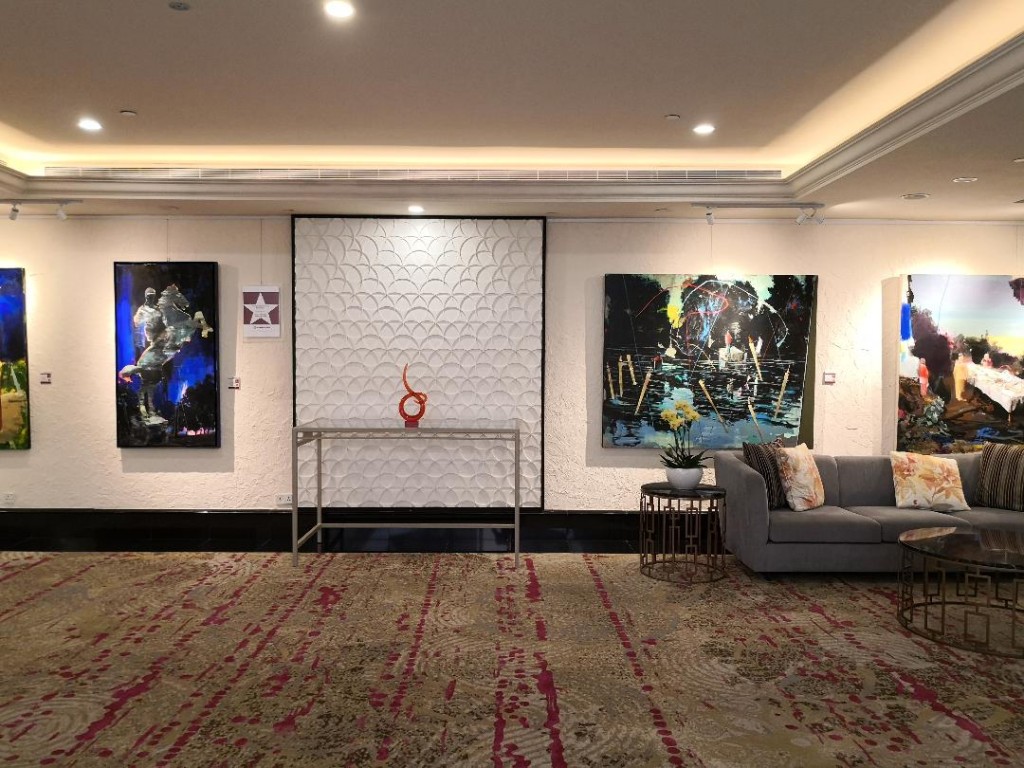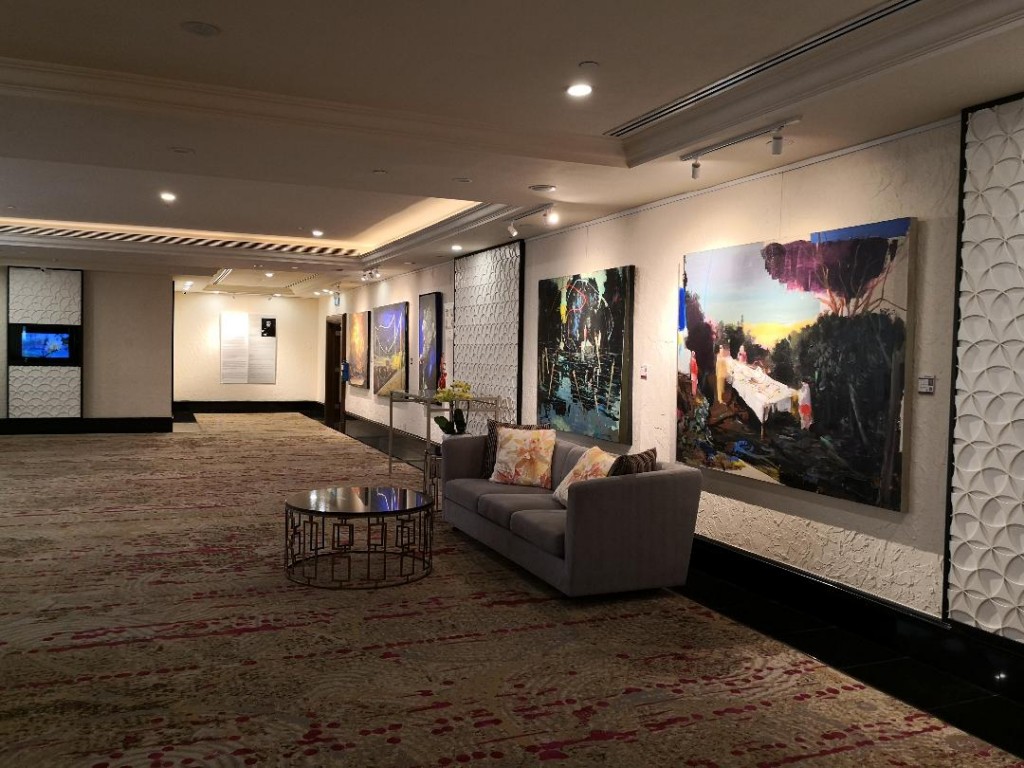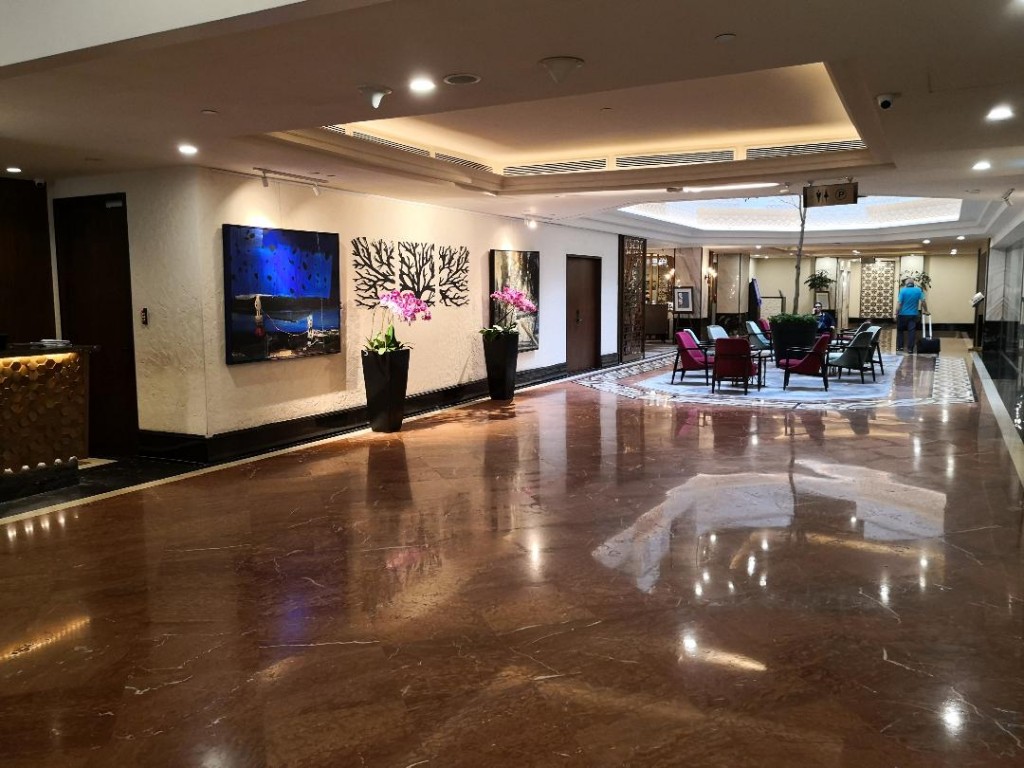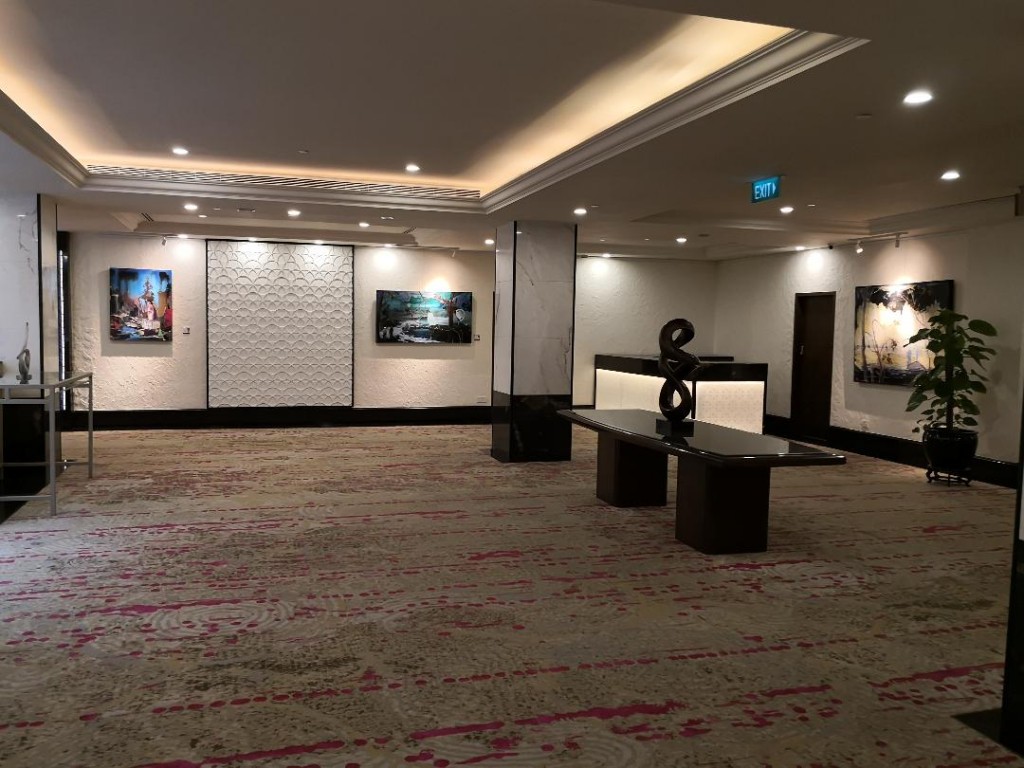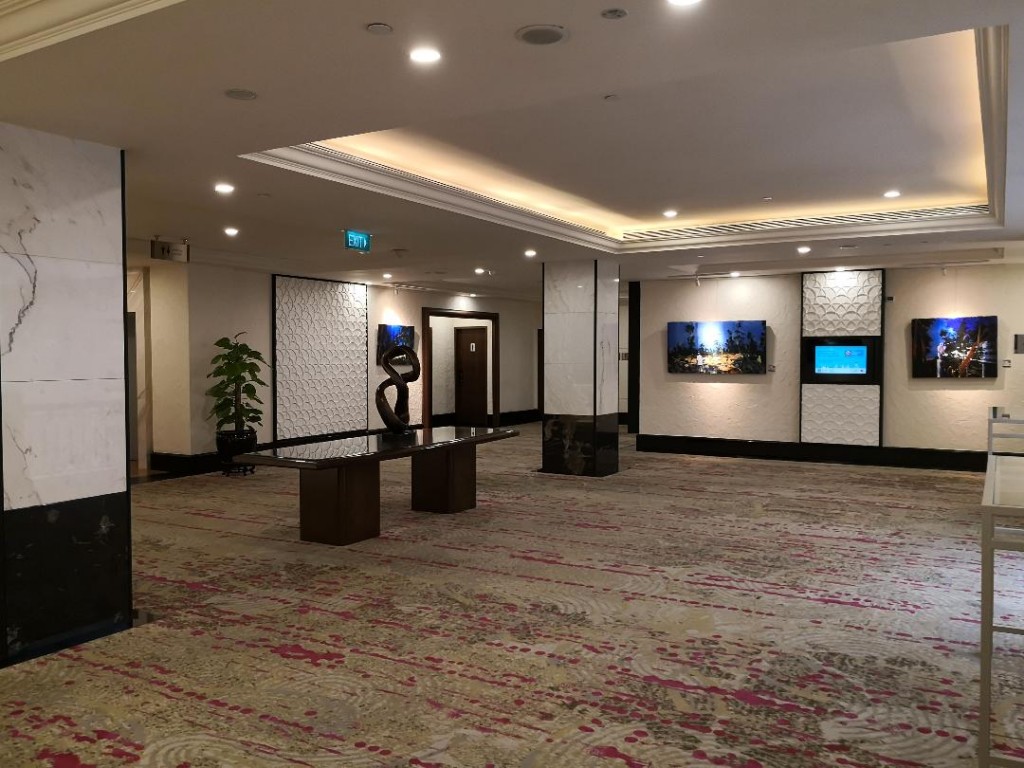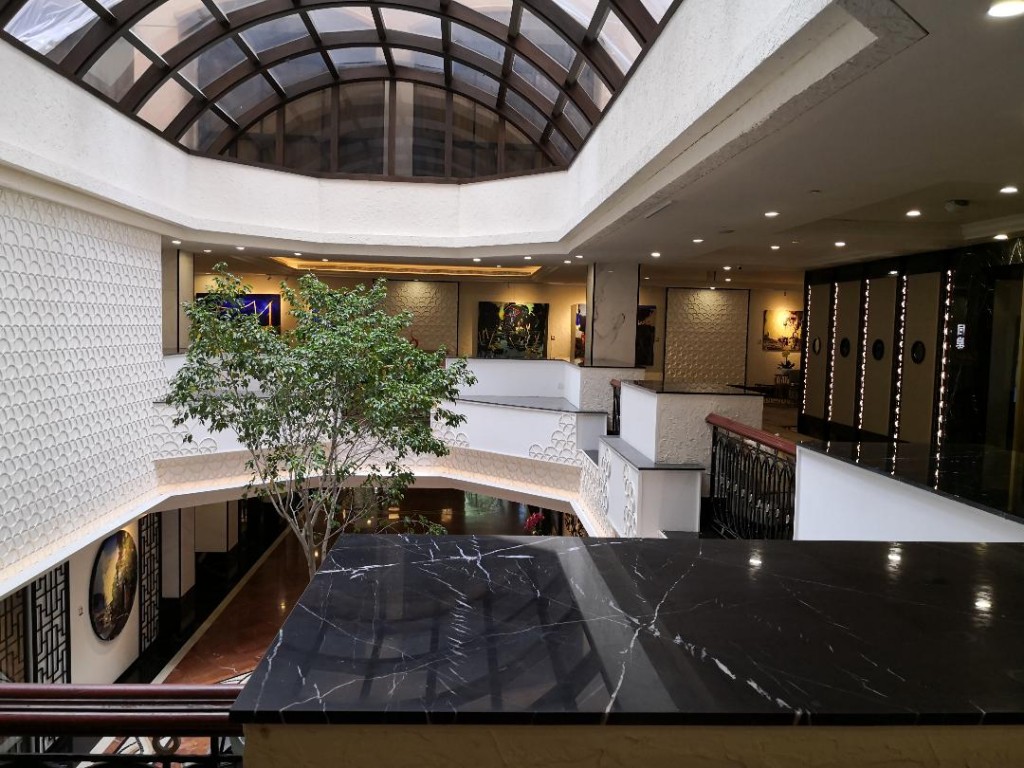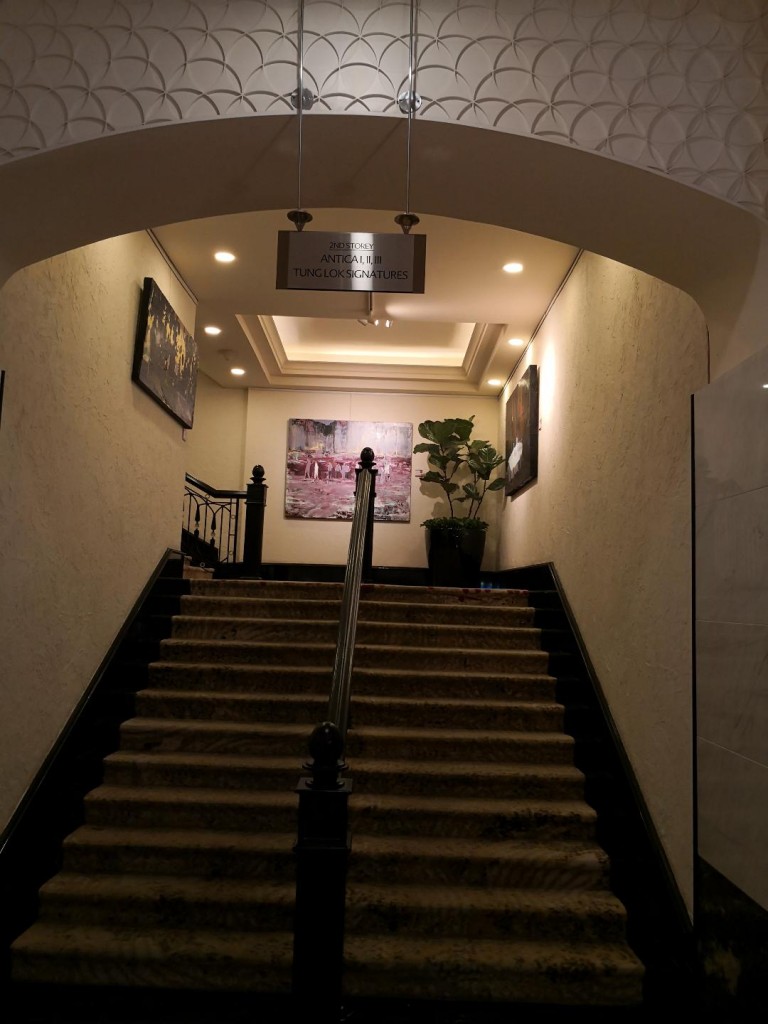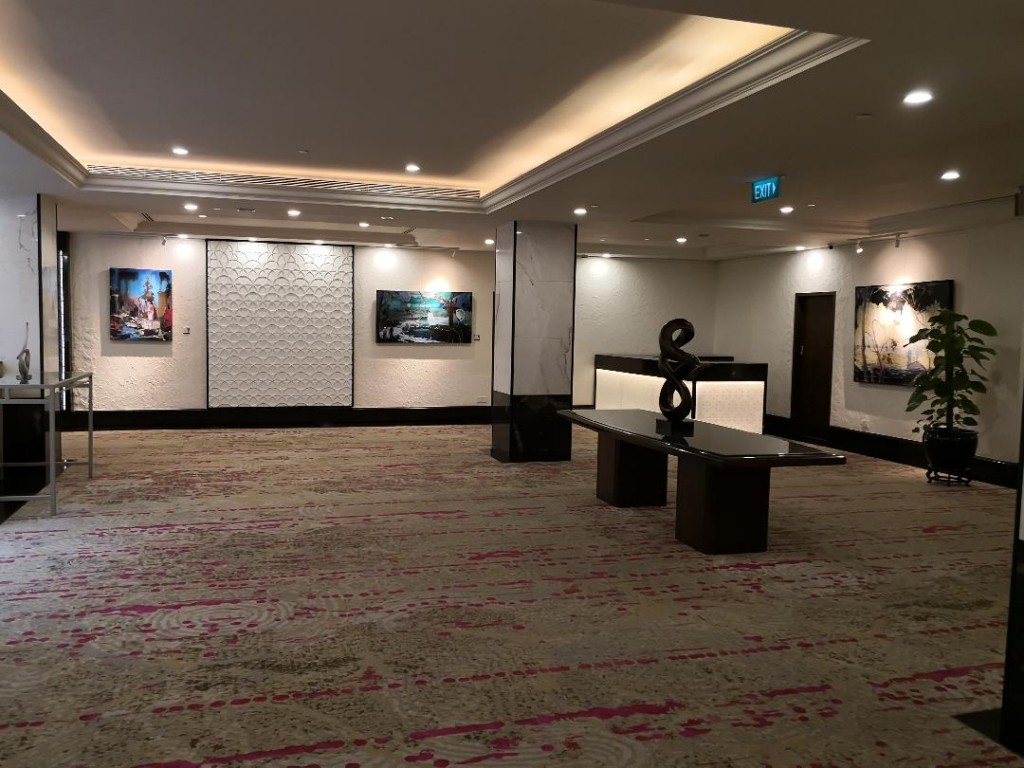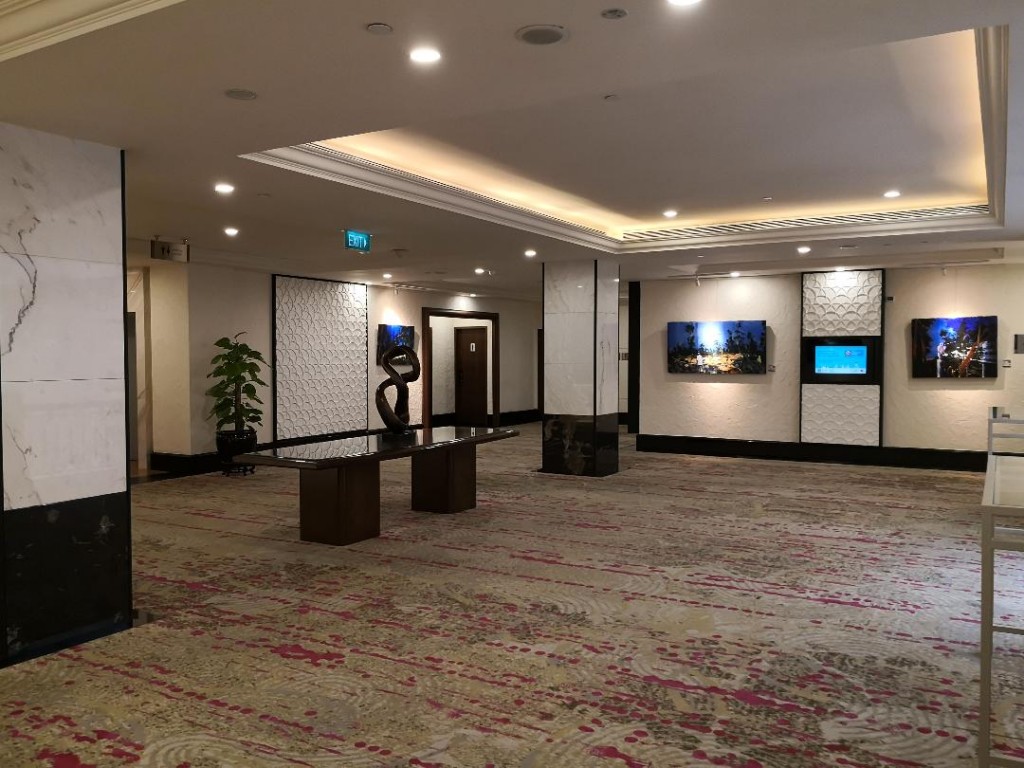Inner Impression – Lu Lin Art Exhibition 29 Feb to 29 Mar 2020
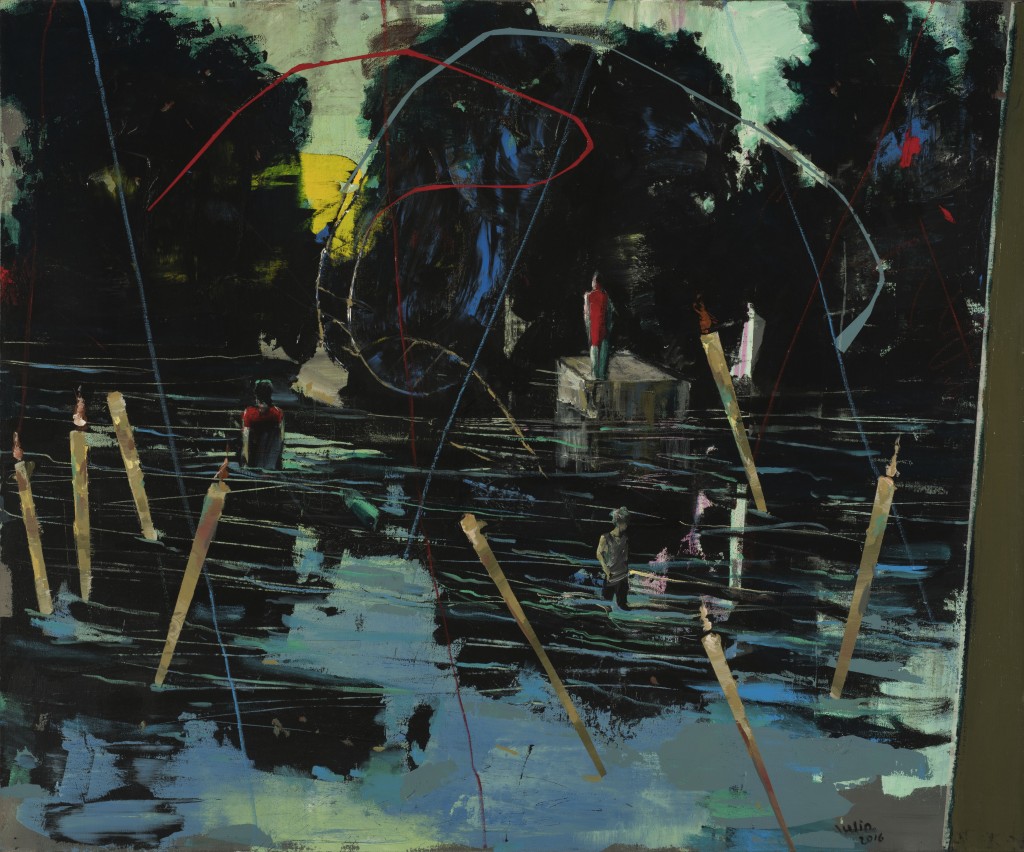
In The Water 2016 145x175cm Acrylic on canvas
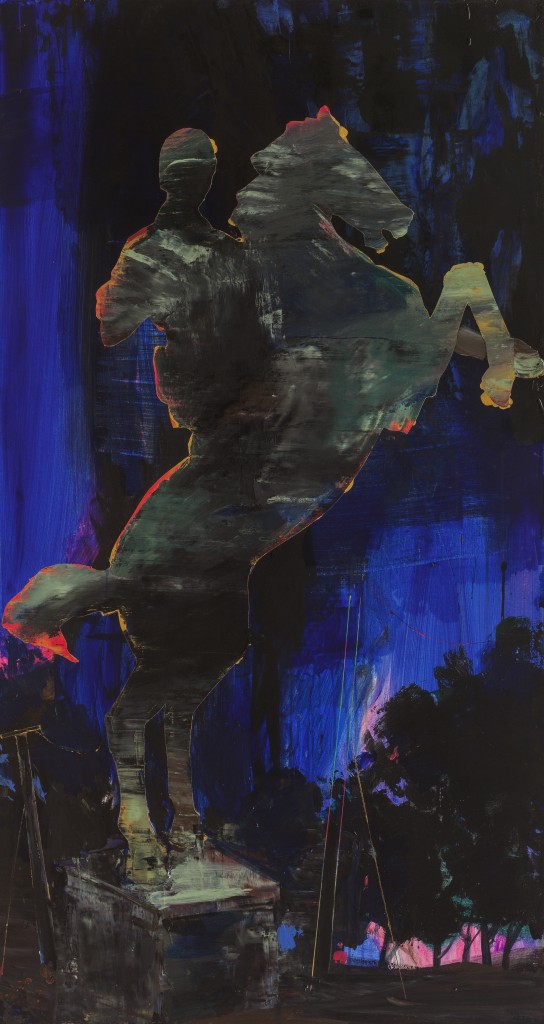
Bright Future 2018 150x80cm Acrylic on canvas
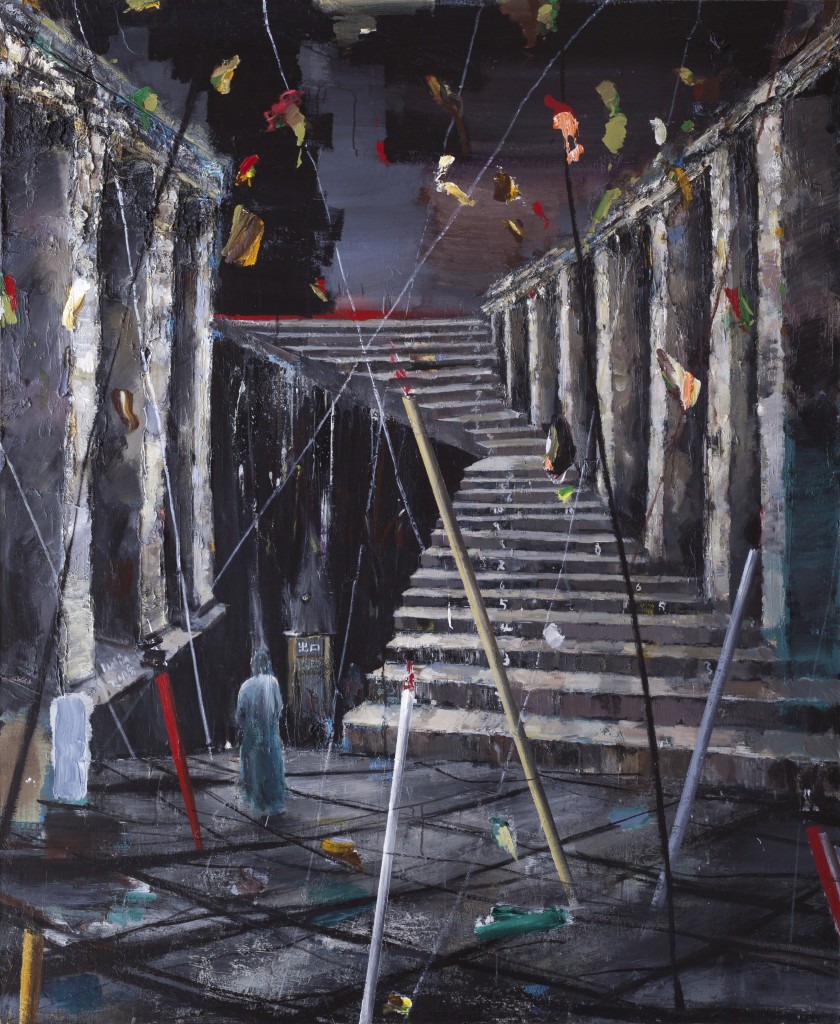
Exit 2014-2016 200x170cm Oil and acrylic on canvas
============
Media coverage:-
============
Lu Lin – New Experiments
Paintings from 2016 and 2017
Experimentation and Innovation
As a serious artist Lu Lin has many strengths: a modern outlook, a sound art foundation and his sensitivity. Two of the most significances are his belief in and his ability in artistic experimentation and innovation. In his work titled Forest he experimented with, and broke new ground in, the important element of composition arrangement. In the work – executed with instinctive swiftness – he created an abstract composition exuding invigoration with his two favourite driving forces – vivid realism and revealing symbolism. In a captivating work titled Three Friends Lu explored the expressive scope made possible by the technical command of sweeping brushwork. Amazingly, Lu succeeded in infusing the brushstrokes with tonal range, sensitive nuances and – most valuable of all – instinctive evocation.
Light and colour
Light and colour, two formidable artistic forces, have fascinated the great artistic talents in modern art history in the West. French artist, Claude Monet and English artist, William Turner – the giants in modern Western art – forged timeless masterpieces. In Lu’s artistic endeavor, the elements light and colour have been – for him – an irresistible challenge. In the work titled Twilight he probed into the flux and change of twilight light and eventually created a work infused with visual mystery, enchantment and beauty. In another work, the painting titled In The Water Lu took the colour black – which was difficult to exploit – to its zenith. With predominant black and a sprinkle of red, blue, green and white he transformed an uninspiring river-scene into a work singing with visual illumination and poetic ecstasy.
Twilight 2016 200 X 150 cm Acrylic on canvas
As a serious painter I am very conscious about maintaining high quality in my artworks. I practice my art incessantly. I managed to produce consistently works of high standards. The works that do not meet my expectation I would destroy them. Destroying my creations is a painful experience.
Lu Lin
The painting with the appealing title Twilight began as an ambitious city’s outskirt scene showered with activities. With typical disarming technical skills Lu immediately struck a captivating and balance composition. Strategic positioning of the explosive fire, the painter and specific groups of people gave rise to a work of tension. In the process of the work Lu was suddenly mesmerized by the fleeting light of twilight. The place was transformed into a dazzling ambience with a silvery sky, glittering reds and browns on the grounds: the visual ecstasy of twilight.
Exit 2014 – 2016 200 X 170 cm Oil and Acrylic on canvas
People in the modern society try desperately to find an exit to escape from life – But they are unaware of the irresistible temptations which distract them from their escape. Success is a powerful temptation. I use the unending stairs to symbolize this.
Lu Lin
Lu’s intention is to create a work of art not through illustration but through interpretation. The work title Exit is a good example of how he deploys the technique of realism and symbolism. The figure symbolizes the person who tries to escape from life; the staircase symbolizes the element of success which lures the person away. The work is characterized by many dynamic elements: the powerful interplay of verticals and horizontals, the haunting atmosphere, the inexplicable mystery.
In The Water 2016 175 X 145 cm Acrylic on canvas
People cannot see their true-self. Like the river water they only see the scene above the water and not under the water. There are all kinds of people. Some are born with silver spoons; others are born disadvantaged. In this work I attempt to highlight this inequality in society through a symbolic approach.
Lu Lin
With imagination and insight into the potential of colour, Lu transformed a limited palette into a work of irresistible visual power and enrichment. Black was a colour that was difficult to manage, yet Lu skillfully exploited it to the full. Adding a patch of vivid blue the river came alive with glittering reflections. With dancing red lines the black trees were rejuvenated. The predominating black created an atmosphere characterized by serenity, mystery and even ecstasy. The monumental scale exuded authority.
The Party 2017 200 X 150 cm Acrylic on canvas
Artists should focus constantly on their artistic pursuit – their artistic practice and the dialogue that enhances it. But in China today artists are obsessed with the politics of their time. I think this is unproductive. In this work I illuminate this irony with a humorous approach.
Lu Lin
The painting titled The Party is essentially realistic but with symbolic overtones. While the intention is a satire on Chinese artists, the work emerges as an enchanting landscape with aesthetic appeal. The predominant black is again the highlight of the work. Skillfully manipulated, Lu Lin’s brushwork could infuse the black trees with random evocative visual nuances creating a romantic yet mysterious atmosphere. Spanning 200 m, the work has a breathtaking visual authority.
Three Friends 2017 150 X 120 cm Acrylic on canvas
There are three good friends. But their personal fortunes are different. One is more fortunate: he is an official and thus enjoys many advantages – authority, power, influence and wealth. The other two have no advantages and thus are helpless. They simply blend into society, faceless. I see this as a serious concern of society.
Lu Lin
This is the type of rare work which captures the viewer’s imagination immediately. Many exciting painting elements interplay to give the work its gripping unity. The unusually bold brushstrokes articulated with lightning swiftness infuse the work with visual dynamism. Then come the colours – they exude the emotional depth reminiscent of the evocation in Chinese ink art. The work has a transcending spirit.
Forest 2017 120 X 150 cm Acrylic on canvas
This work is about the destruction of the forests. Why cut down the trees and deprive us from the rich variety of fruits? Why destroy the forest which enhances our environment? Forest destruction is about money, about greed. In this work I want to highlight such harmful practices.
Lu Lin
One of the appealing strengths in Lu’s artistic endeavor is his flair in artistic re-invention. The work titled Forest is a good example. The work seized the viewer’s imagination instantly. With three dynamic forces – vivid realism, revealing symbolism and suggestive elements of abstraction – Lu created an irresistible visually work with eclectic elements. The grey-black-white colour- scheme heightened the mystery in the work. Forest is a work which grows on the viewer.
W. Y. Choy
Artist, Art Curator
Singapore
2019
============
By Sun Guanghua
As a predecessor of the art world, I once had an in-depth dialogue with Lu Lin. We started by exploring the differences between our two generations. We all agree that in my generation, Chinese contemporary art is conceptually clear, straightforward and popularized. It then moves into the ambiguous semantics of their generation, at least looking from their shelf paintings.
Touching about he himself, he disagreed with the critics who attributed him to the surrealism because of the ambiguity of his artworks. As for some other critics, who feel that his paintings are filled with loneliness and inability to escape, this is the misunderstanding of his art of existentialism. In contrast, he agreed more with me about his works. He creates a truth about our existence in the Zen-style – Jifeng zhuanyu “机锋转语” (high capabilities possessed by grandmasters) — It is a “mute language”; a “complicated public case” in the current context; a “revelation” without a standard answer; or even an “intellectual game” of a daydreamer.
In addition, we also discussed about the attitude of our two generations with regard to the painting technique. Relatively speaking, the last generation of contemporary artists seem to be deliberately de-technical, and some of them even assume the role of art revolutionary emphasizing that technique is not important. Lu Lin’s generation I noticed, seems to enjoy the role of the “builder” in the art technique. They even created some “slang” for this, such as the new term “hand feel” specifically referring to Lu Lin and this kind of painters.
Finally, we talked about the most realistic and cruel topic of “art ecology”, that is, the survival of professional artists. Lu Lin’s calmness on his own future and his steady growth in the art market finally made me deeply relieved.
============
The Tension Between Implied and Exposed – Lu Lin’s Painting
By Du Xiyun
The complex combination of known and unknown, controllable and uncontrollable makes the “contemporary” full of uncertainty. It is like the waves carrying a large number of sand and stone, or the airflow of the wind and cloud, running at high speed and unpredictable. Ordinary people are full of confusion and helplessness in the glory of this era. This is especially true living in contemporary China.
Lu Lin’s paintings, between realistic and abstract, seem to have narratives. When scrutinized, they have no traces, because the main picture is poetic emotions. They are indescribable feelings of life. He uses a wide brush stroke, mottled texture, high-purity but gloomy color tone to create a magnificent world. The simple contours outline the figurative people and things – small, weak, lonely or moving or quiet…
The scenes of these paintings are mostly from daily life, like a series of visual diaries, which retain the living memory of ordinary people. The emotional sadness and depression that fills the picture, combined with the turbulence, joys and sorrows of this era, can reversely speculate on the specific problems hidden behind these emotions. However, the artist’s restraint on the scale of the specific social and cultural issues is stopped. The true feelings accumulated by countless specific details can be said in a thousand words, but on the two-dimensional canvas, the artist transforms them into rich poetics in an aesthetic way, they speak but stop and want to speak. Words, between the subtleties of the form / mood and the exposed, form the tension of aesthetics and psychology, pointing to the situation and mentality of many ordinary people.
Contemporary art is in a muddle. Only a few can survive as a classic under the heavy filter of the historical network. But the energy and charm of contemporary art lie in its immediate response to what is happening to the human heart. The fate of being chosen after the passage of time is not important here and now. The aesthetic way and psychological state expressed in Lu Lin’s works are being “contemporary” at present. The once enthusiasm of globalization is now going against globalization. In the turbulent shock, a new era is gradually opening, and intractable entanglements are being dragged in endlessly. The energy radiated in this process deepens people’s degree of confusion. The resulting mentality is very complicated, but it is as difficult to explain as a person in the fog. Looking at Lu Lin’s works in this context, the perceptual information is quite able to echo the psychological state of many ordinary people.
Of course, one step backwards, in the era of materialism and successful learning, if the people who are weak and marginal do not have a self-contained culture to resist the mainstream, they are in the social desert zone. Their hearts are ridiculous and cold. They feel that the society, the time, and the natural universe are all sad and depressed. Can artists release these emotions through aesthetics, and even transform them into poetic?
10 October 2019, Beijing
===============
Lu Lin — Lonely Incomplete Participant
By Lloyd Zhao Hong – Singapore artist, curator, critic
When I saw Lu Lin’s works, Vasily Kandinsky’s words echoed in my ears: “Color is the key, the eye is the hammer, and the heart is the string of the piano”.
However, if you associate these words with the imaginary beauty, it is wrong. Lu Lin’s piano keys come from an abandoned vacant room. The walls are broken. The piano has been shattered, lying numbly on the ground, not even wanting to moan. Lu Lin’s eyes are not bright. Both the forest and the city have been haze filtered. Because of the sorrow and loneliness, he can’t see loveliness and beauty. There is no emotion at all. Standing on the balcony, his hands are long enough to reach probably a fruit. Oh no, it might not even be a fruit. It may be a good-looking garbage flying up.
Life and reality have become fragmented, but he still wants to participate. Whether participating or not participating, this is a question. The question is beyond his control. In the end, Lu Lin chooses not to participate fully. He steps back and uses a brush to lift up the eyelids, idly observing this boring world with lingering light.
If Lu Lin pays attention to the expression of symbols, he has indeed done it. In his works, the symbols are specific and clear. The hidden symbols can also directly touch the hearts of the audience. His color is not strong, and the composition of the picture is even too loose. People feel a little intentional confusion. However, in a seemingly careless arrangement, he creates an atmosphere, a helpless and defeated atmosphere. When this atmosphere gradually spreads, the audience realizes the mood and emotion of the painter, a kind of depression after struggling.
People don’t need to be courageous at all times. They don’t need to be full of sunshine at all times. Sometimes, decadence is also a right choice.
The negative and helpless cynicism; accepting and following the reality of experience; obtaining rationality by not believing; these are the social and cultural form that Lu Lin intended to express in his works. Do not believe in the enthusiasm of others. Do not believe in the righteous words of others. Do not believe in the so-called cry of justice. Even do not believe that there is any way to change the world that cannot be believed. Dissatisfaction with the existing order turns into “indifference without rejection”; “sobriety without resistance”; “acceptance without approval” etc are felt in reading his art pieces — “Since the world is such a big absurdity and a big joke, I can only treat it with absurdity and joke.”
Only commenting on technique and genre are of low level. When our attention to the artworks focus only at this level, we are just the hyenas yelling at the lion on the grassland. Once the lion leaps, it can easily kill the barking hyenas and despises the dead bodies. We should pay attention to the painter’s heart through the picture, even if the picture is covered by dirty colors, which are deliberately done. At times, the picture is cut by the soft and weak lines, it is again intentionally. We must be patient and look back, because behind the picture is the artist’s heart, even if sometimes he is deliberately not letting you read.
In this world, it doesn’t matter what’s right or wrong, because there are enough skeptics who think there’s no such thing as right or wrong. Lu Lin’s work is probably something like that.
================
On the Ash of History and Human Nature —
A Glimpse of Lu Lin’s Ruins-themed Painting
Hao Qingsong
In the aftermath of World War II, the Germans have long not recognized themselves as criminals. In post-war courts, the state and war criminals were brought to justice, but this was not enough for the citizens, as individuals, to be forgiven by history. Not until twenty years later when Kiefer’s art bravely challenged this collective silence that the people of Germany, and even Europe, was freed from the burden of sin. Later, when Kiefer and Neo-Expressionism set foot in China, it meant not only the introduction of a different style or tradition, but also the inspiration of a sociological dimension in art.
Having followed the example of Kiefer, some Chinese contemporary artists aspire to build a link between their artworks and social and historical memory, and to vividly record history in their paintings. It is a backdrop that young artists cannot escape from as they still live in the unfinished historical heritage of modern times. Be it in the west or the east, modern history can be regarded as an extension of civilized order, the inheritance of the original sin, and furthering the efforts for the salvation of life. No wonder the land of China has witnessed Mr D and Mr S (nicknames for Democracy and Science created by Chen Duxiu, a fierce critic of traditional Confucian rituals in China), Opium Wars, colonialism, and even Christian martyrs. This is road and process led to many ruins as a result of self-conceit. Therefore, this was a vicious road to culture, which justifies a saying that goes, “Don’t test us with temptation but save us from evil.” Compared with the vicious history, contemporary society is more like a road probing the nature of being human.
Still being in the midst of fierce trials, the young artists have become bogged down in another round of challenges. In Gramsci’s forecast of “cultural hegemony”, both in concept and practice, culture as tool is more effective than threats. Developing from popular culture, the consumer society proves to be most effective in achieving cultural hegemony. Consequently, many young artists, represented by the stars of contemporary art, get lost under the neon lights, and take the pleasure of consumption to be freedom. Trapped by the illusion of freedom, they are merely soulless walking bodies. This is unconscious spiritual bondage. The more successful they are, the more enslaved. The truth is that no sooner has this generation embarked on a promising journey that they run into a Berlin Wall.
Yet not everyone has been affected this way; there are a few artists who have painted the grand yet nihilistic ruins of pain.
It has been a decade since Lu Lin graduated from Tianjin Academy of Fine Arts and settled down in Songzhuang. On his journey towards his dream, Lu Lin is assiduous and persevering as Sisyphus. His intuition engulfs every day of his life in the suffering of a century, the symbol and radiation of Auschwitz. Although times have passed and circumstances have changed, there is still nothing new under the sun. Some artists may focus on the various events of Auschwitz, but Lu Lin is immersed in every bit of it, never absent for a single moment. Every day of deep despair in the haze is the reflection of Auschwitz. From iron cages to consumption and from fierceness to temptation, everything means a crushing defeat in the Battle of Waterloo for his dreams. In an absolute judgment, if possibly made, the whole world is full of Auschwitz-like tragedies in its essence, Auschwitz being the most painful one. The tragedy exists everywhere. Why is ancient Greece known for its tragedies? Why did Wang Guowei say China had no tragedy? In this regard, the significance of Chinese art that evades the tragic nature is questionable, as is the Chinese contemporary art. Artists of the previous generation generally chose to face the world with negative liberty that was cynical and ridiculous as a response to the special social realities at that time. Unfortunately, such attitude has been inherited by many young artists. That is the deepest tragedy and despair. It does not arise from the inability to extricate themselves from the tragedy, but the complete insensitivity towards the truth of the reality. Indeed, the era of imitation has become increasingly sophisticated, like the gorgeous buildings have towered into the sky. But can deco art cover up the restlessness in life? Confronted by temptations, art has been unexpectedly reduced to the accomplice of evil.
Indeed, efficient as the world order under cultural hegemony may be, hidden inside is a complex network of power, just like the social ecosystem revealed in a Peking University student’s doctoral thesis “Cadres in Chinese Counties and Townships” as well as in Foucault’s Panopticon, a metaphor that allowed him to state his theory that knowledge is power. Such secret got vividly manifested in the almost ubiquitous lines in Lu Lin’s drawing. These lines appear as a clutter of bare wires in the countryside and counties, collectively as a dividing line that keeps the high-end entertainment above the golf course away from the low-end population, and even a loud warning at the scene of an accident. In essence, they reveal tacit collusion, the equivalent to the historical fable of Laocoon strangled by snakes. If the lines in Zhang Xiaogang’s drawing symbolize blood and life, then those created by Lu Lin mean decoding and leakage of a secret. The dense network of lines weaves an invisible structure of society. Tough and sharp, it imprisons the physical body and deprives people of freedom. Yet inside it is too fragile and fearful to stand too much strain. Lu Lin’s artwork has nothing to do with the countryside scenery, but portrays the world landscape of the 20th century, an era of radicalism when the world slipped into an utter chaos, wrecking everything solid. The arrogance of modernity has reached its apex, and such darkness could accommodate nothing but the full glow of the raging fire, which devours, in an instant, the order of civilization surviving centuries. Flying high in the ashes is the arrogant lines. Logs cut by humans are being built into prisons for instrumental reason. The scene of ruins, as revealed in Lu Lin’s drawing, seems to be the symbol and legacy of Auschwitz, but actually it could be traced back to the original sin of stealing the forbidden fruit in the Garden of Eden and believed to be the legacy of Cain’s killing of Abel. To conclude, the modernity also gives full expression to a complicated system of lines deeply rooted in human nature.
The new Berlin Wall has no visual or tactile form, which completely frustrates the mimesis proposed by Plato and Vasari. Yet it seems so ubiquitous that it encircles the physical body and even penetrates into the body to be part of it, turning people into victims of the Stockholm syndrome. The closest personal experience of such feeling arises from the lingering haze. We all know it is harmful yet still we need to breathe. We all want to scatter it but we cannot even touch it. We all wish to go through it but the thick haze is just like an impenetrable wall that keeps the blue sky away from us. Such is the case with the internet world that we can’t live without for even one moment today. This is also the invisible ceiling that young men have encountered, a ceiling that isolates them from poetry and even the place faraway. Indistinct in the gray haze is but the temptation of science of art success consuming youth and life. Those silver-salt grays and oversaturated blues in the sky are filled with such artistic temptations. The decoration, however beautiful, is another form of a fatal haze. The lingering sky lanterns in the winter night bear some resemblance to wisdom myths that are soon devoured by the haze. In Lu Lin’s painting, the world is left in a heap of rubble, and despite the different chromaticity between the facade and the sky, the whole world seems dark as if covered in a dense fog. That’s both the background of the ruins and the end of the world, exhausting everyone involved yet getting them nowhere – a silent ending seemingly predicted by Cui Jian three decades ago.
What about human nature in the world? We hate to admit we’re living in an era unworthy of truth. Yet we can’t escape from it, neither can we do something about it. Useless silence. That’s all most of us have. The only destiny left over for us is to leave behind the reality for the virtual one, the unknown future. That’s the exact feeling that characters in Lu Lin’s works convey to us: be him a bystander or a witness, everyone turns back on the scene without the courage to look straight into it. Why? That’s not only the problem facing Germany after World War II, but also a matter of original sin. When the earliest ancestors of human were questioned by God for stealing the forbidden fruit, neither Adam nor Eve took their responsibility, a cowardly escape from the original sin. This story seems to justify people’s weakness. Lu Lin’s way of expression proves to be the most loyal to reality instead for he depicted the deepest weakness in human nature. Humans invariably turn and go away, noncommittal. Just like how Friedrich explained the Natural Theology in his landscape paintings in the early 19th century, it seems that artists may break down with set practices of idolatry by avoiding figures on the front side in artworks, yet by doing so they actually evade the real problem of human nature. Once confronted by another temptation and viciousness, humans will fall into the same old trap again.
Without any way out, Lu Lin has to resort to artistic creation, in a hope to catch a glimpse of the world’s secrets. From time to time, he gets sentimental, or confident. Those weak figures are believed to be a reflection of himself, standing still among the ruins and gazing at the future, helpless. Inevitable is the pain of growth, the same pain with Laocoon’s sufferings when he was strangled by snakes and the temptation from a snake that our ancestors indulged in. The young people who are in their most brilliant years harden their heart in artistic creation, and their maturity also gets revealed in the artworks.
Lu Lin’s paintings of ruins are influenced by the style of expressionism, which is proved essential and effective. More importantly, his expression of the situation opens a window into the dark side of society and human nature as well as the essence of the chaotic and fragile world. Without being blindly optimistic, he confronts the truth that to escape reality is human. Weak as well as he may be, he tries to be sincere, and separates his artworks from contemporary art as consumer culture and from that in the form of social narrative. While concerning for cultural politics as always, he commendably digs deep into human nature and takes it as an instrument in serious reflection upon society.
Standing on the ashes of history and human nature, it is neither art nor society that matters, but human nature.
===============
Exhibition Photos:-
